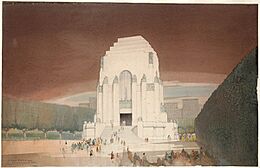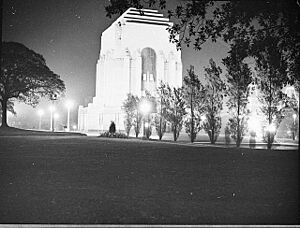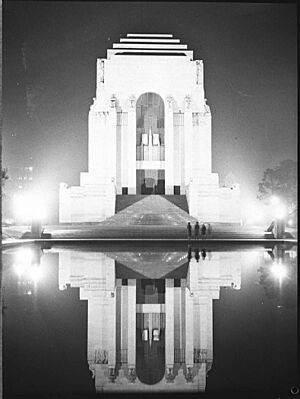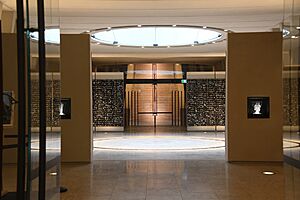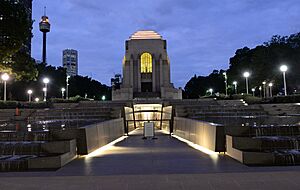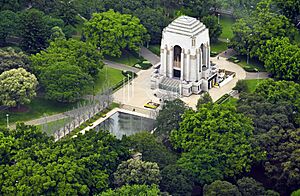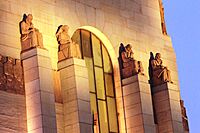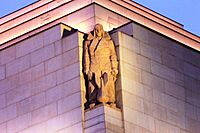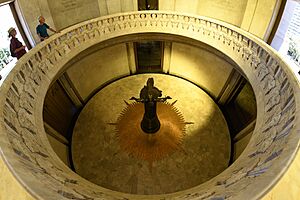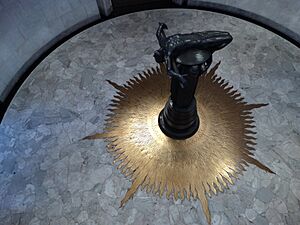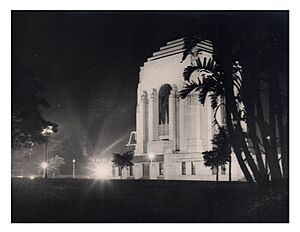Anzac Memorial facts for kids
Quick facts for kids Anzac Memorial |
|
|---|---|
| Australia | |
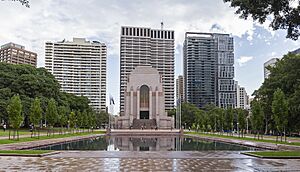
Anzac Memorial, Hyde Park, Sydney
|
|
| For the Australian Imperial Force dead of World War I | |
| Unveiled | 24 November 1934 |
| Location | 33°52′32″S 151°12′39″E / 33.87556°S 151.21083°E |
| Designed by |
|
| Official name: Anzac Memorial; War Memorial Hyde Park; Hyde Park Memorial | |
| Type: | State heritage (built) |
| Criteria: | a., b., c., d., f., g. |
| Designated: | 23 April 2010 |
| Reference #: | 1822 |
| Type: | War Memorial |
| Category: | Monuments and Memorials |
| Builders: | Kell & Rigby |
The Anzac Memorial is a special building in Hyde Park, Sydney, Australia. It is a war memorial, a museum, and a monument. It reminds us of the brave Australians who served in wars.
This amazing building was designed in the Art Deco style by C. Bruce Dellit. Rayner Hoff created the sculptures and carvings on its outside. It was built between 1932 and 1934.
The memorial is a very important place for ceremonies. People gather here on Anzac Day and Remembrance Day. It was first built to honor the Australian Imperial Force from World War I.
Money for the memorial started being collected on April 25, 1916. This was the first anniversary of the Australian and New Zealand Army Corps (ANZAC) landing at Gallipoli. The memorial officially opened on November 24, 1934. In 2018, it was made even better with new parts and was reopened by Prince Harry, Duke of Sussex.
Contents
- History of the Anzac Memorial
- Ancient Aboriginal Land
- What Does "Anzac" Mean?
- Ideas for War Memorials in Australia
- Planning the Anzac Memorial
- The Cenotaph in Martin Place
- Designing the Anzac Memorial
- Building the Memorial
- Opening Ceremony, November 24, 1934
- Offices at the Memorial
- How the Memorial's Meaning Changed
- Centenary Extension
- What the Anzac Memorial Looks Like
- See Also
History of the Anzac Memorial
Ancient Aboriginal Land
Long ago, Aboriginal people lived in the Sydney Harbour area. Evidence shows they were here at least 25,000 years ago. The Gadigal people were the traditional owners of inner Sydney, where the Anzac Memorial now stands.
It is thought that the southern part of Hyde Park was a "contest ground." Here, Aboriginal warriors would have friendly fights. The British settlers watched these trials in the early days of the colony. It's interesting that such an important war memorial is on this historic site.
What Does "Anzac" Mean?
The word "Anzac" started as a short way to say "Australian and New Zealand Army Corps." This was during World War I. But soon, "Anzac" became a word on its own.
The Anzacs were part of a large force from Britain and France. They tried to invade the Gallipoli Peninsula. Their goal was to open the Dardanelles Straits for the British Navy. Australian Anzacs showed great courage at Gallipoli. Their bravery became a famous part of Australian military history.
After leaving Gallipoli, the Anzac soldiers fought against Germany. They fought on the Western Front in Europe. The Light Horse soldiers protected the Suez Canal. They also fought in the Middle East.
On Anzac Day in 1918, Australian soldiers stopped a German attack. This happened at Villers-Bretonneux on the Somme. Australians were known as strong fighters. They helped break through the Hindenburg Line in their last big attack.
Australia had about 4.5 million people at the time. About 416,809 men joined the army and navy. This was half of all men old enough to fight. Sadly, 60,000 Australians died and 167,000 were injured. This was a very high number compared to other British Empire countries.
People who returned from the war wanted to remember their fallen friends. The first Anzac Day in New South Wales was organized by soldiers. They wanted to remember the dead and raise money for a memorial. In 1925, Anzac Day became a public holiday in New South Wales.
Ideas for War Memorials in Australia
Historian Ken Inglis says that war memorials changed in the 1900s. They started to remember the human cost of war. They honored ordinary soldiers, not just leaders. These memorials often listed the names of those who died. They also listed those who returned home. This idea of listing everyone was unique to Australia. It showed that all soldiers were volunteers.
Each major city in Australia built its own main memorial. Many smaller ones were built in towns and suburbs. Here are some of the main memorials and when they were built:
- Darwin Cenotaph, Darwin – 1921
- War Memorial, Hobart − 1925
- State War Memorial Cenotaph, Perth – 1928–1929
- Shrine of Remembrance, Brisbane – 1930
- National War Memorial, Adelaide – 1931
- Shrine of Remembrance, Melbourne – 1928–1934
- ANZAC Memorial, Sydney – 1934
- Australian War Memorial, Canberra – 1941
The Anzac Memorial in Sydney and the Shrine of Remembrance in Melbourne are very similar. Both are large, important buildings. They have a main space for remembering. They also have rooms for offices and exhibitions.
Planning the Anzac Memorial
In 1918, a group of returned soldiers shared their goals for the memorial:
- It should be a memorial for those who died.
- It should be a beautiful building.
- It should have offices to help war widows and children.
- It should keep records of the Australian Imperial Force.
- It should be a meeting place for soldiers.
- It should help with future efforts for soldiers and their families.
There was a lot of discussion about where to build it. Eventually, part of Hyde Park was chosen. There were also debates about the style of the memorial. Soldiers wanted a useful building. Women's groups preferred a beautiful, commemorative structure.
After ten years, everyone agreed on a "shrine of remembrance." This meant it would be a place to remember, not just offices. However, some funding was still set aside for offices. These offices would help returned soldiers.
The Cenotaph in Martin Place
While the Anzac Memorial was being planned, Sydney needed a place for Anzac Day ceremonies. Around 1925, a cenotaph (a monument to those buried elsewhere) was built in Martin Place. This was where wartime rallies had been held.
The Cenotaph was dedicated on August 8, 1927. It became the main spot for Anzac Day ceremonies. The Dawn Service for Anzac Day stayed at the Cenotaph. Martin Place had strong connections to the war.
Designing the Anzac Memorial
A competition was held on July 13, 1929, to design the memorial. Architects from Australia could enter. They could also work with a sculptor. The building cost was limited to 75,000 Australian pounds.
The building also needed office space for soldier groups. There were 117 entries in the competition. Bruce Dellit won first prize. The building was constructed by Kell & Rigby. Most people agreed Dellit's design was the best.
Dellit explained his design was inspired by "ENDURANCE COURAGE AND SACRIFICE." He wanted the central sculpture, "Sacrifice," to be in a lower chamber. This would encourage visitors to quietly reflect.
Bruce Dellit, the Architect
Charles Bruce Dellit was born in Australia. He studied architecture in Sydney. He opened his own practice in 1929. Dellit was a pioneer of the Art Deco style in Australia. He used lots of decoration and symbolism in his buildings.
For the Anzac Memorial, Dellit used sculptures and architecture to show sadness. He wanted to remember the many young men from New South Wales who died. He worked with sculptor Rayner Hoff. Hoff added figures representing different parts of the armed services.
The Pool of Reflection on the north side was Dellit's idea. It invites people to stop and remember. The central sculpture, "Sacrifice," was Hoff's work. But the emotional design of the interior was Dellit's.
Dellit designed grand staircases leading to the Hall of Memory. Visitors must bow their heads to see "Sacrifice" below. Or they can look up at the dome. It has 120,000 golden "Stars of Memory." Each star represents a serviceman or woman from New South Wales. Dellit's design and Hoff's sculptures work together beautifully.
The Anzac Memorial is seen as Dellit's greatest work. It is called "the epitome of Art Deco in Australia." Dellit died of cancer in 1942, just eight years after the memorial opened.
Rayner Hoff, the Sculptor
Rayner Hoff was born in 1894 on the Isle of Man. He worked in a stonemason's yard as a teenager. He later studied art and sculpture. Hoff served in the army on the Western Front in 1916. After the war, he studied sculpture in London.
Hoff came to Sydney in 1923. He became a head teacher of sculpture. He had a big impact on Australian sculpture. Many talented sculptors learned from him.
In 1930, Dellit asked Hoff to create the sculptures for the Anzac Memorial. This became the most important work of Hoff's career. He created 16 seated and 4 standing figures of servicemen and women. He also made relief carvings and bronze panels.
Hoff also designed the 120,000 gold stars on the dome. He made four relief panels showing "The March of the Dead." These represented the Army, Navy, Air Force, and Army Medical Corps. He also designed the marble wreath around the Well of Contemplation.
Hoff made sure to include women in the memorial's design. This included nurses and women who lost family members. He explained that women carried the "sacrifice of their menfolk."
Some of Hoff's designs caused controversy. Two large bronze groups for the outside of the building showed naked figures. People criticized these designs. Hoff eventually destroyed the models. These sculptures were never completed. Hoff died in 1937.
Building the Memorial
The memorial was built using Australian materials and workers. The main contractors were Kell & Rigby. They hired many returned servicemen. Many other skilled workers helped too.
The building was made of red granite from Bathurst. The steps and terrace were also made of granite and terrazzo.
In 1932, Dellit added four stones from battlefields. These came from Gallipoli, France, Palestine, and New Guinea. They were placed in the Hall of Memory. The names of major battles were added to the walls.
The dome of stars was a later idea. It helped raise money for the memorial. People could buy stars for two shillings each. Although not all were sold, 120,000 gold-painted plaster stars were put on the ceiling. Each star represented a volunteer from New South Wales.
The interior walls were lined with unpolished marble. The floors were polished marble. The original plans for bronze doors were changed to maple doors. These were decorated with bronze nails. The large amber windows were etched with the AIF symbol and eternal flames.
Dellit planned for the offices at the base of the building to become part of the memorial later. The offices had wooden floors and fittings. An Assembly Hall was added on the eastern side. It could seat 130 people.
The original inscriptions for the memorial were also changed. Experts decided on simpler messages. For example, the foundation stones say, "A soldier set this stone" and "A citizen set this stone." This showed that both soldiers and citizens helped build it.
The landscaping around the memorial was also changed. Dellit wanted water gardens. The northern pool was made much larger. The City Council completed the landscaping. They planted poplars along the pool. These trees symbolize the French battlefields.
Opening Ceremony, November 24, 1934
About 100,000 people came to the opening of the Anzac Memorial. The ceremony showed that the building was for everyone. Prince Henry, Duke of Gloucester gave the dedication speech. The Anglican Archbishop of Sydney gave a prayer.
A special book was published in 1934. It explained the memorial's meaning and symbolism. Building magazine also featured the memorial. It described its details and meaning.
Offices at the Memorial
The offices in the Anzac Memorial helped soldiers. They assisted with applications and medical needs. Each office had a counter, a waiting area, and staff.
By the mid-1930s, the offices were crowded. This became worse when World War II veterans needed help. The RSL (Returned and Services League) moved to a nearby building in 1957. Other groups also moved or returned later. The Limbless and Maimed Soldiers' Association stayed in the memorial.
How the Memorial's Meaning Changed
Less than five years after it opened, World War II began. People started to see the Anzac Memorial as a memorial for all wars. It became a symbol for all conflicts Australia was involved in.
During protests against the Vietnam War in the 1960s, the memorial became a gathering point. It was also used for anti-war protests. In 1975, feminists painted "Women march for Liberation" on it.
In 1984, a law officially changed the memorial's purpose. It became the main war memorial for New South Wales. It now honors all men and women from New South Wales who served in any war.
In the same year, a museum opened inside the memorial. It teaches people about Australia's wars. A Remembrance Flame was added to the Hall of Memory in 1995. It is lit for several hours each day.
The Anzac Memorial is seen as a beautiful and important building. It is a "unique statement of architectural and sculptural unity." It continues to inspire Australians to remember those who served.
Centenary Extension
In August 2016, work began on a big upgrade. This $40 million extension was part of the Centenary of Anzac. It marked 100 years since the end of World War I.
The extension added new underground exhibition and education spaces. It completed architect Bruce Dellit's original vision. The upgrades included:
- A large waterfall on the south side, with a new entrance.
- The Hall of Service, with an artwork by Fiona Hall. This artwork uses 1,701 soil samples from towns where soldiers lived.
- The Oculus, a circular opening above the Hall of Service.
The extension opened on October 20, 2018. It won top awards for public architecture in 2020.
What the Anzac Memorial Looks Like

The memorial is made of concrete and covered in pink granite. It has a square shape with Art Deco steps and supports. Each side has a large arched window of yellow stained glass. The roof is stepped, like a ziggurat.
It sits on a cross-shaped base. This base holds offices and a small museum. The inside is mostly white marble. The domed ceiling has 120,000 gold stars. Each star represents a serviceman or woman from New South Wales in World War I.
You can enter the main hall by wide stairways. Ground-level doors on the east and west lead to the lower section. The most important part inside is Rayner Hoff's bronze sculpture, "Sacrifice." It shows a deceased soldier held up by three women. These women represent his mother, sister, and wife.
The building's outside has many bronze carvings. It also has carved granite panels and twenty large stone sculptures. These sculptures symbolize military personnel.
North of the memorial is a large "Lake of Reflections." Rows of poplar trees line the lake. These poplars are not from Australia. They symbolize the battlefields of France.
- The Memorial's Surroundings
The Anzac Memorial is a key feature in Hyde Park South. It lines up with the Pool of Reflection and the Archibald Fountain in Hyde Park North. You can see the memorial from many parts of the park.
The trees around the memorial are also symbolic. Aleppo pine trees are planted around the building. They connect to Lone Pine Ridge at Gallipoli. Other special trees, like the Gallipoli Rose, are also nearby. The 14 poplar trees by the Pool of Remembrance were planted in 1934.
The pool was repaired in 1992 to make it waterproof. This work also included paving around the memorial.
Two rows of flagpoles stand between the pool and the memorial. They are used on Anzac Day and other special events. Six flags fly permanently. Three show the New South Wales flag, and three show the Australian national flag. A flagpole on the memorial itself is for the Governor's Flag. It is only used when the Governor visits.
- The Outside of the Building
The Anzac Memorial was designed to be like a sculpture. It is perfectly balanced on both sides. It uses parts that remind you of old churches, like buttresses and tall windows. But it uses them in an Art Deco style.
Grand staircases lead up to the main level. Urns sit on the railing around this level. Large wooden doors slide into the walls to let people in. The ground floor has wooden windows and bronze security grilles.
Many sculptures decorate the outside. They represent different Australian armed forces. They are like "sentinels" or guards, watching over the memorial. They remind us of those who died.
Four large standing figures are at the top of each corner. They represent the Infantry, Navy, Air Force, and Army Medical Corps. Sixteen seated figures are below them. These represent different units, like a Naval Signaller or a Nurse. They look like they are carved from the building's stone.
Above the east and west entrances are bronze carvings. They show Australians fighting on the Eastern and Western Fronts. These bronze carvings are in good condition.
- The Inside of the Building
The main entrance from the ground floor is on the west side. The entrance area is lined with white marble. Two wooden cabinets are built into the walls. A large brass "Star" light, designed by Dellit, is in the ceiling.
This entrance leads to offices and exhibition areas. A lift was added in 2009. It helps older veterans and people with disabilities reach the Hall of Memory. The remaining staircase has a bronze, Art Deco skylight.
At the edge of the Stair Hall is a barred entrance to the Hall of Silence. A heavy bronze railing blocks the way to the "tomb" of the fallen soldier. Words engraved in the floor say, "LET SILENT CONTEMPLATION BE YOUR OFFERING."
At the top of the stairwell is a marble-framed niche. It holds the original wreath laid at the building's opening.
- Hall of Silence
This room is in the center of the building. It is very simple and powerful. The room is round. The "Sacrifice" sculpture is in the middle. The floor is white marble with a bronze flame design.
The ceiling curves up to a circular opening called the "Well of Contemplation." This opening lets natural light shine onto the sculpture below. A marble carving around the top lists the names of major battles.
Three large, gold-painted wooden doors are in the room. Two are now left open. This lets visitors see the "Sacrifice" sculpture from other areas.
- Sacrifice Sculpture
At the heart of the memorial is the bronze sculpture, "Sacrifice," by Rayner Hoff. It shows the great cost of war. It reminds us of those who fight and those who wait at home.
You can see the sculpture from above through the Well of Contemplation. You can also see it from the ground level. It is even visible from Hyde Park through the glazed doors.
- Hall of Memory
The "Hall of Memory" is a round room directly above the "Hall of Silence." It is also covered in marble. In the center is a marble railing around the "Well of Contemplation."
In the four "corners" of the room are "Niches of Remembrance." Each niche is for a major area where Australians fought in World War I. The names of battles are carved into the walls. At the bottom of each niche is a headstone from a battlefield.
Above the niches are marble carvings by Rayner Hoff. These represent the Army, Navy, Air Force, and Army Medical Corps. They are called "The March of the Dead."
The high, domed ceiling has 120,000 gold stars. Each star represents a man or woman from New South Wales who served in the war. Four tall, etched amber glass windows add to the room's height.
To the east is the Remembrance Flame Room. This room was meant to list the names of those who died. Above the doorway is "1914–1918" and a flaming sword symbol. The Remembrance Flame was first lit on November 11, 1995. The doors are left open so the flame can always be seen.
- The Exhibition Space
The exhibition space is where the RSL offices used to be. It was changed in 1986. It displays items donated by the public. These include letters, medals, uniforms, and diaries. They tell stories about Australia's conflicts.
In 2009, the space was updated for the memorial's 75th anniversary. A new exhibition was installed.
- The Assembly Hall
The Assembly Hall is on the eastern side. It was designed for meetings. It has been restored and is now open to the public. It has new glass doors and shows a short film about the Memorial. It can also host traveling exhibitions.
The room has detailed Art Deco designs. The ceiling has molded coffers. The walls have plaster pilasters. Gold-painted doors open to reveal the "Sacrifice" sculpture. The original lights and switches are still in use. The floor is made of red mahogany wood.
- Offices for Soldier Associations
The northern side of the memorial originally had offices for soldier associations. These included the TB Soldiers Association and the Limbless Soldiers Association. They had wooden floors and counters.
Some of these offices have been changed over time. In 2009, new meeting rooms and offices were created. The Limbless Soldiers Association moved out in 2004. The RSL has used the area since then. Three original strong rooms (safes) are still in the building.
- Basement
The basement has toilets for men and women. The original wooden lockers are still used by staff. Some changes have been made, but many original parts are still there. A new disabled toilet was added in 2009.
Two light wells originally brought fresh air and light to the toilets. They now hold air conditioning equipment. The basement floors are terrazzo. The toilet partitions are marble.
- Undercroft and Security Screens
The undercrofts are under the outside stairs. They were meant for storage. In 1992, they were made waterproof. The north undercroft now stores old furniture.
In 1999, security screens were added to protect the memorial. These glass panels have etched designs. They are lowered during the day for public access.
- The Great Doors and Windows
There are ten sets of large doors in the building. They are made of solid silky oak wood with brass fittings. The outside doors are green, and the inside is gold. They slide into the walls.
The doors are decorated with carvings of urns, flames, swords, and crosses. These symbols relate to the memorial's purpose. The doors were repaired and repainted in 2006.
- Moveable Heritage
The memorial has many artifacts and tributes. These are displayed in the museum or stored on site. They were all donated by the public.
- Building Services
In 2009, the building's services were updated. This included new air-conditioning, lighting, and security systems. Many original electrical fittings, like switches and lights, are still used. The "star lights" designed by Dellit are throughout the building.
Condition of the Memorial
As of early 2010, the memorial was in very good condition. Water leaking into the building had been a problem since 1934. This was fixed in 2009 with changes to the drainage system.
Archaeology
The area around the memorial has a rich history. Hyde Park was once Australia's first race course and cricket pitch. It may also have been an Aboriginal "fighting ground." There might still be historical evidence underground.
The Anzac Memorial is very well preserved. It still has many original features. This includes items like the wreath laid by the Duke of Gloucester.
Heritage Importance
The Anzac Memorial, finished in 1934, is very important to New South Wales. It shows the sadness felt by people for Australian servicemen and women lost in wars. Fundraising for it started on the first anniversary of the Gallipoli landing.
It is also connected to returned soldiers and groups like the RSL. These groups pushed for the memorial and had offices inside it. The memorial is a beautiful example of Art Deco design in Australia. It was created by architect Bruce Dellit and sculptor Rayner Hoff. Their work together made a powerful and symbolic building.
Its location in Hyde Park, with the Pool of Reflection and poplar trees, was carefully planned. It is a key part of Sydney's city landscape. The Anzac Memorial is the largest and most ambitious war memorial built in New South Wales after World War I. It is one of the "national war memorials" built in each state capital. It stands out for its size, completeness, and beauty.
The Anzac Memorial is important because:
- It shows the history of New South Wales. It represents the sadness for soldiers lost in war. It also provided jobs during the Great Depression.
- It has strong links to the Gallipoli landing. This event greatly shaped Australian identity. An Aleppo Pine from Gallipoli is planted nearby. It is also linked to Bruce Dellit and Rayner Hoff, who are famous for their work on this building.
- It is a great example of Art Deco art and architecture. It combines architecture and sculpture beautifully. It is praised for its "unity of architecture, carving and sculpture."
- It is a major place for public remembrance. It helped people accept the term "Anzac" and its legend. It is still a key part of Anzac Day each year. Its sculptures also honor the role of women in war, which was rare for its time.
- It is a rare and impressive example of Art Deco public architecture. It is the grandest war memorial in New South Wales.
- It shows the main features of important war memorials. It is the largest and most ambitious memorial built in New South Wales after World War I.
See Also
- ANZAC Memorial (Israel)
- Australian War Memorial – Australia's national war memorial and museum in Canberra
- El Alamein Fountain
- HMAS Sydney I – SMS Emden Memorial
- Hobart Cenotaph – Hobart's main war memorial
- National War Memorial (South Australia) – Adelaide's main war memorial
- Regimental Square
- Shrine of Remembrance – Melbourne's main war memorial
- Shrine of Remembrance, Brisbane – Brisbane's main war memorial
- Sydney Cenotaph


